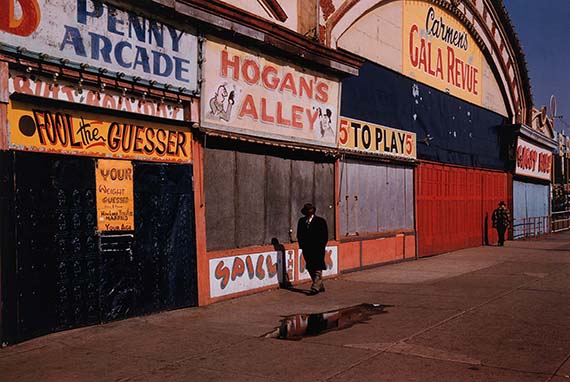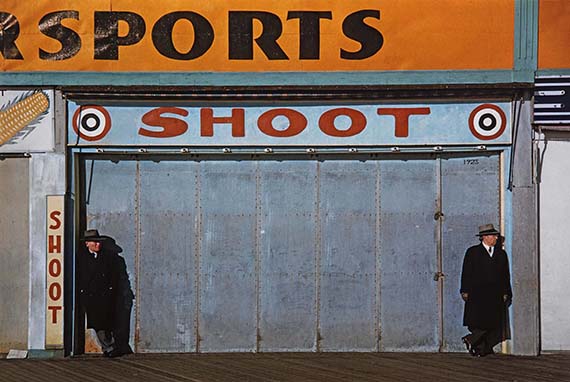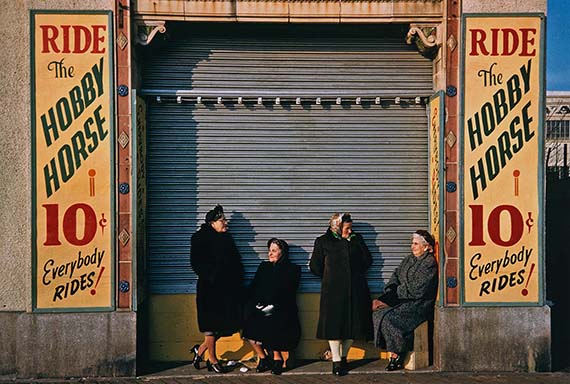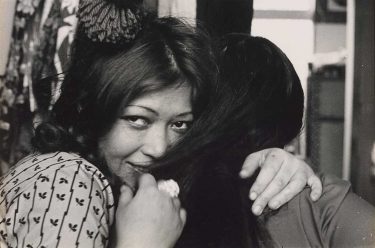
The Gallery has nine colour photographs by North American photographer Marvin Newman — four prints from his series ‘Coney Island’ 1953, and a complete set of five prints from the ‘Wall Street’ series 1956.
The photographs taken by New York photographer Marvin Newman in the 1950s that make up the series ‘Coney Island’ 1953 and ‘Wall Street’ 1956 appear as if they were a sequence of film stills shot on location during the making of an ambiguous film noir. Taken in the bright glare of the late afternoon sun, the Coney Island images show figures loitering or passing in front of otherwise deserted amusement stalls in the shabby laneways near the Brooklyn neighbourhood’s waterfront, while the photographs taken on Wall Street capture anonymous businessmen emerging from and receding into the shadows of the iconic Lower Manhattan location. Shot on 35mm Kodachrome colour slide film — which produced a distinct, subtle colour tone — and made using only the available natural light, Newman’s street photography was groundbreaking for the era.
Marvin Newman studied at Brooklyn College with documentary photographers Walter Rosenblum (1919–2006) and Berenice Abbott (1898– 1991) before undertaking a master’s degree with modern art photographers Harry Callahan (1912–99) and Aaron Siskind (1903–91) at the Institute of Design in Chicago in 1949–52. While completing his master’s thesis, Newman developed his interest in the idea of the photographic series, a theme that he would reiterate throughout his career. Following his return to New York, in 1953 Newman was included in ‘Always the Young Strangers’, an exhibition of emerging photographers held at the Museum of Modern Art. In the press release for the exhibition, which describes Newman as exploring through his work the ‘fantastic shadows of people on the street’,1 the exhibition’s curator Edward Steichen observed:
The refusal of the preceding decade to be bound to any group or ‘ism’ still holds: however, the dominant tendency of the great majority of our young photographers today is towards photo-journalism.2
From the 1930s, documentary and photojournalism had come to define much of the most progressive international modern art photography. In New York, the presence of the editorial offices of new, influential, illustrated magazines was fundamental in shaping the city’s cultural and creative climate, creating a unique environment for the development of a New York school of photography. Photojournalism became a way of life for many of the most prominent street photographers working in New York in the 1940s and 50s, and Newman was among a number to work independently on such projects while receiving commercial commissions.
Reflecting, perhaps, the influence of the magazine editorial format on his fine art practice, Newman created series of small sequences of images, suggestive of carefully constructed but undefined narratives — not common practice among street photographers of the period, who tended to make ongoing series extending over many years. With only a small group of photographers using colour film for non-commercial work in the 1950s, colour remained at the margins of modern art photography until the arrival of photographers such as William Eggleston (b.1939) and Stephen Shore (b.1947) in the 1970s. In recent years, there has been a reassessment of early colour street photography, pioneered by photographers such as Newman in the 1950s.
Sally Foster is former Assistant Curator International Art (pre 1975), QAGOMA
Endnotes
1 Press release for ‘Always the Young Strangers’, Museum of Modern Art, New York, 25 February 1953, archived online <http://www.moma.org/docs/press_archives/1683/releases/MOMA_1953_0013_13.pdf?2010>, viewed 4 September 2013.
2 Press release.
Subscribe to YouTube to go behind-the-scenes / Hear artists tell their stories / Read more about your Australian Collection / Know Brisbane through its Collection
#QAGOMA





Marvin’s Kodachrome’s are beautiful. Funny how colour was not accepted and seen as a film for serious photographers. Many bodies of work are being discovered. None is greater from that period than Fred Herzog who shot mainly in Vancouver. http://www.equinoxgallery.com/artists/portfolio/fred-herzog